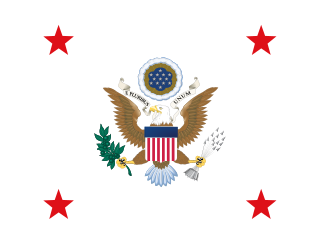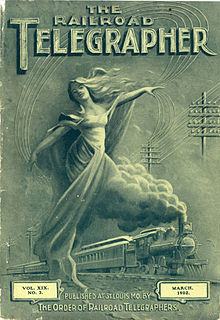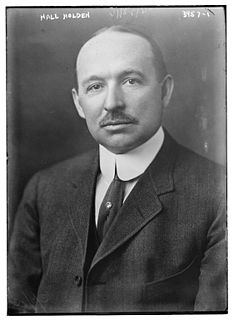Related Research Articles

The Interstate Commerce Commission (ICC) was a regulatory agency in the United States created by the Interstate Commerce Act of 1887. The agency's original purpose was to regulate railroads to ensure fair rates, to eliminate rate discrimination, and to regulate other aspects of common carriers, including interstate bus lines and telephone companies. Congress expanded ICC authority to regulate other modes of commerce beginning in 1906. Throughout the 20th century, several of ICC's authorities were transferred to other federal agencies. The ICC was abolished in 1995, and its remaining functions were transferred to the Surface Transportation Board.
The Railway Labor Act is a United States federal law on US labor law that governs labor relations in the railroad and airline industries. The Act, enacted in 1926 and amended in 1934 and 1936, seeks to substitute bargaining, arbitration and mediation for strikes to resolve labor disputes. Its provisions were originally enforced under the Board of Mediation, but they were later enforced under a National Mediation Board.
The Mann–Elkins Act, also called the Railway Rate Act of 1910, was a United States federal law that strengthened the authority of the Interstate Commerce Commission (ICC) over railroad rates. The law also expanded the ICC's jurisdiction to include regulation of telephone, telegraph and wireless companies, and created a commerce court.
The Transportation Act, 1920, commonly known as the Esch–Cummins Act, was a United States federal law that returned railroads to private operation after World War I, with much regulation. It also officially encouraged private consolidation of railroads and mandated that the Interstate Commerce Commission (ICC) ensure their profitability. The act was named after Rep. John J. Esch and Sen. Albert B. Cummins.

The Timeline of U.S.A Railway History depends upon the definition of a railway, as follows: A means of conveyance of passengers and goods on wheeled vehicles running on rails, also known as tracks.

Wooden railroads, called wagonways, were built in the United States starting from the 1720s. A railroad was reportedly used in the construction of the French fortress at Louisburg, Nova Scotia, in New France in 1720. Between 1762 and 1764, at the close of the French and Indian War (1756–1763), a gravity railroad is built by British military engineers up the steep riverside terrain near the Niagara River waterfall's escarpment at the Niagara Portage in Lewiston, New York.

Albert Baird Cummins was an American lawyer and politician. He was the 18th governor of Iowa elected to three consecutive terms and U.S. senator for Iowa serving for 18 years.

The United States Railroad Administration (USRA) was the name of the nationalized railroad system of the United States between December 28, 1917, and March 1, 1920. It was the largest American experiment with nationalization, and was undertaken against a background of war emergency following American entry into World War I. During its brief existence, the USRA made major investments in the United States railroad system, and introduced standardized locomotive and railroad car classes, known as USRA standard. After the end of World War I, while some in the United States advocated for continuing nationalization, ultimately the railroads were returned to their previous owners in early 1920.

The 65th United States Congress was a meeting of the legislative branch of the United States federal government, composed of the United States Senate and the United States House of Representatives. It met in Washington, DC from March 4, 1917, to March 4, 1919, during the fifth and sixth years of Woodrow Wilson's presidency. The apportionment of seats in this House of Representatives was based on the Thirteenth Census of the United States in 1910.

The 66th United States Congress was a meeting of the legislative branch of the United States federal government, comprising the United States Senate and the United States House of Representatives. It met in Washington, DC from March 4, 1919, to March 4, 1921, during the last two years of Woodrow Wilson's presidency. The apportionment of seats in the House of Representatives was based on the Thirteenth Census of the United States in 1910.
The United States Railway Association (USRA) was a government-owned corporation created by United States federal law that oversaw the creation of Conrail, a railroad corporation that would acquire and operate bankrupt and other failing freight railroads. USRA operated from 1974 to 1986.

John Jacob Esch was an American attorney and member of the United States House of Representatives from 1899 to 1921 serving as a Republican. Born near Norwalk, Wisconsin, he graduated from the University of Wisconsin in 1882 and in 1887 was admitted to the bar. He was a member of the Interstate Commerce Commission from 1921 to 1927. In 1928, President Calvin Coolidge granted him a recess appointment pending his confirmation to a second term; however, the Senate blocked the nomination and the recess appointment expired when Congress adjourned in May. Esch returned to the practice of law and died in La Crosse, Wisconsin.

The United States Assistant Secretary of War was the second–ranking official within the American Department of War from 1861 to 1867, from 1882 to 1883, and from 1890 to 1940. According to the Military Laws of the United States, "The act of August 5, 1882 authorizing the appointment of an Assistant Secretary of War was repealed by the act of July 7, 1884 the power conferred by the act of August 5, 1882 never having been exercised," indicating that the post was not filled between 1882 and 1883.
The Erdman Act of 1898 was a United States federal law pertaining to railroad labor disputes. The law provided for arbitration for disputes between the interstate railroads and their workers organized into unions.

Walker Downer Hines was an American railroad executive and second Director General of the United States Railroad Administration.
The Valuation Act is a 1913 United States federal law that required the Interstate Commerce Commission (ICC) to assess the value of railroad property. This information would be used to set rates for the transport of freight.

The Newlands Labor Act, was a 1913 United States federal law, sponsored by Senator Francis G. Newlands of Nevada and drafted by Bureau of Labor Statistics Commissioner Charles Patrick Neill. It created the Board of Mediation and Conciliation (BMC). The BMC was a precursor to today's National Mediation Board (NMB).

The Railroad Labor Board (RLB) was an institution established in the United States of America by the Transportation Act of 1920. This nine-member panel was designed as means of settling wage disputes between railway companies and their employees. The Board's approval of wage reductions for railroad shopmen was instrumental in triggering the Great Railroad Strike of 1922. The Board was terminated on May 20, 1926 when President Calvin Coolidge signed a new Railway Labor Act into law.

The Order of Railroad Telegraphers (ORT) was a United States labor union established in the late nineteenth century to promote the interests of telegraph operators working for the railroads.

Hale Holden was president of the Chicago, Burlington and Quincy Railroad (CB&Q) from 1914 to 1918 and 1920 to 1929, and chairman of the board of directors for Southern Pacific Railroad from 1932 to 1939. He was one of the lawyers working for James J. Hill's defense team in the Minnesota Rate Cases. In later years he served as a director for a number of large companies including American Telephone & Telegraph, New York Life Insurance Company and the Chemical Bank & Trust.
References
- ↑ Presidential Proclamation 1419, December 26, 1917, under authority of the Army Appropriation Act, 39 Stat. 45, August 29, 1916.
- ↑ Huddleston, Eugene L. (2002). Uncle Sam's Locomotives: The USRA and the Nation's Railroads. Indiana University Press. ISBN 978-0-2533-4086-3.
- ↑ Esch–Cummins Act, Pub.L. 66-152, 41 Stat. 456. Approved 1920-02-28.
- ↑ U.S. National Archives, Washington, D.C. "Records of the United States Railroad Administration." Accessed 2012-03-26.
- ↑ USRA abolished By Reorganization Plan No. II of 1939, effective July 1, 1939.